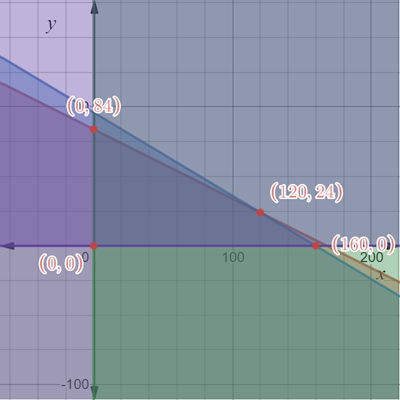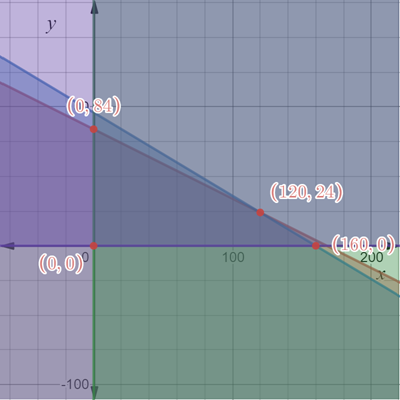
a.
To calculate:The number of small and large package to maximize the revenue.
a.
Answer to Problem 27PPS
The number of small packages are 160 to have maximum revenue.
Explanation of Solution
Given information:
The small packages weigh 25 pounds and 3 cubic feet capacity each. Large packages weigh 50 pounds and have 5 cubic capacity each. 4200 pounds of cargo and capacity of 480 cubic feet is hold by train. $5 is charged for each small package and $8 is charged for each large package.
Calculation:
Consider the provided information thatsmall packages weigh 25 pounds and 3 cubic feet capacity each. Large packages weigh 50 pounds and have 5 cubic capacity each. 4200 pounds of cargo and capacity of 480 cubic feet is hold by train. $5 is charged for each small package and $8 is charged for each large package.
Let x denote the number of small package and y denote the number of large packages.
The constraints are,
Since, $5 is charged for each small package and $8 is charged for each large package.
The objective function or revenue function is,
Plot the above inequalities on coordinate plane.

The shaded region represents the feasible. It is a quadrilateral with 4 corner points. The coordinates of feasible region are
Substitute the vertices of the feasible region to find the point at which maximum profit is there.
Substitute
Substitute
Substitute
Substitute
Thus, the maximum revenue is when 160 small packages are placed.
b.
To calculate:The maximum revenue per train car.
b.
Answer to Problem 27PPS
The maximum revenue per train car is $800.
Explanation of Solution
Given information:
The small packages weigh 25 pounds and 3 cubic feet capacity each. Large packages weigh 50 pounds and have 5 cubic capacity each. 4200 pounds of cargo and capacity of 480 cubic feet is hold by train. $5 is charged for each small package and $8 is charged for each large package.
Calculation:
Consider the provided information thatsmall packages weigh 25 pounds and 3 cubic feet capacity each. Large packages weigh 50 pounds and have 5 cubic capacity each. 4200 pounds of cargo and capacity of 480 cubic feet is hold by train. $5 is charged for each small package and $8 is charged for each large package.
Let x denote the number of small package and y denote the number of large packages.
The constraints are,
Since, $5 is charged for each small package and $8 is charged for each large package.
The objective function or revenue function is,
Plot the above inequalities on coordinate plane.

The shaded region represents the feasible. It is a quadrilateral with 4 corner points. The coordinates of feasible region are
Substitute the vertices of the feasible region to find the point at which maximum profit is there.
Substitute
Substitute
Substitute
Substitute
Thus, the maximum revenue is $800 which is when 160 small packages and 0 large packages are placed.
c.
To explain:The maximization of revenue per train car is benefitted for the company or not.
c.
Answer to Problem 27PPS
The maximization of revenue per train car is notbenefitted for the company. As people cannot ship large packages from one destination to other.
Explanation of Solution
Given information:
The small packages weigh 25 pounds and 3 cubic feet capacity each. Large packages weigh 50 pounds and have 5 cubic capacity each. 4200 pounds of cargo and capacity of 480 cubic feet is hold by train. $5 is charged for each small package and $8 is charged for each large package.
Calculation:
Consider the provided information thatsmall packages weigh 25 pounds and 3 cubic feet capacity each. Large packages weigh 50 pounds and have 5 cubic capacity each. 4200 pounds of cargo and capacity of 480 cubic feet is hold by train. $5 is charged for each small package and $8 is charged for each large package.
Let x denote the number of small package and y denote the number of large packages.
The constraints are,
Since, $5 is charged for each small package and $8 is charged for each large package.
The objective function or revenue function is,
Plot the above inequalities on coordinate plane.

The shaded region represents the feasible. It is a quadrilateral with 4 corner points. The coordinates of feasible region are
Substitute the vertices of the feasible region to find the point at which maximum profit is there.
Substitute
Substitute
Substitute
Substitute
Thus, the maximum revenue is $800 which is when 160 small packages and 0 large packages are placed.
The maximization of revenue per train car is not benefitted for the company. As people cannot ship large packages from one destination to other.
As zero large packaged are placed in train for maximum revenue so people will look for carrier alternatives to transfer large packages from one place to another.
Chapter 3 Solutions
Algebra 2
Additional Math Textbook Solutions
University Calculus: Early Transcendentals (4th Edition)
Pre-Algebra Student Edition
Introductory Statistics
Elementary Statistics: Picturing the World (7th Edition)
Basic Business Statistics, Student Value Edition
- 1. Given that h(t) = -5t + 3 t². A tangent line H to the function h(t) passes through the point (-7, B). a. Determine the value of ẞ. b. Derive an expression to represent the gradient of the tangent line H that is passing through the point (-7. B). c. Hence, derive the straight-line equation of the tangent line H 2. The function p(q) has factors of (q − 3) (2q + 5) (q) for the interval -3≤ q≤ 4. a. Derive an expression for the function p(q). b. Determine the stationary point(s) of the function p(q) c. Classify the stationary point(s) from part b. above. d. Identify the local maximum of the function p(q). e. Identify the global minimum for the function p(q). 3. Given that m(q) = -3e-24-169 +9 (-39-7)(-In (30-755 a. State all the possible rules that should be used to differentiate the function m(q). Next to the rule that has been stated, write the expression(s) of the function m(q) for which that rule will be applied. b. Determine the derivative of m(q)arrow_forwardSafari File Edit View History Bookmarks Window Help Ο Ω OV O mA 0 mW ర Fri Apr 4 1 222 tv A F9 F10 DII 4 F6 F7 F8 7 29 8 00 W E R T Y U S D பட 9 O G H J K E F11 + 11 F12 O P } [arrow_forwardSo confused. Step by step instructions pleasearrow_forward
- In simplest terms, Sketch the graph of the parabola. Then, determine its equation. opens downward, vertex is (- 4, 7), passes through point (0, - 39)arrow_forwardIn simplest way, For each quadratic relation, find the zeros and the maximum or minimum. a) y = x 2 + 16 x + 39 b) y = 5 x2 - 50 x - 120arrow_forwardIn simplest terms and step by step Write each quadratic relation in standard form, then fi nd the zeros. y = - 4( x + 6)2 + 36arrow_forward
- In simplest terms and step by step For each quadratic relation, find the zeros and the maximum or minimum. 1) y = - 2 x2 - 28 x + 64 2) y = 6 x2 + 36 x - 42arrow_forwardWrite each relation in standard form a)y = 5(x + 10)2 + 7 b)y = 9(x - 8)2 - 4arrow_forwardIn simplest form and step by step Write the quadratic relation in standard form, then fi nd the zeros. y = 3(x - 1)2 - 147arrow_forward
- Step by step instructions The path of a soccer ball can be modelled by the relation h = - 0.1 d 2 + 0.5 d + 0.6, where h is the ball’s height and d is the horizontal distance from the kicker. a) Find the zeros of the relation.arrow_forwardIn simplest terms and step by step how do you find the zeros of y = 6x2 + 24x - 192arrow_forwardStep by step Find the zeros of each quadratic relation. a) y = x2 - 16xarrow_forward
 Algebra and Trigonometry (6th Edition)AlgebraISBN:9780134463216Author:Robert F. BlitzerPublisher:PEARSON
Algebra and Trigonometry (6th Edition)AlgebraISBN:9780134463216Author:Robert F. BlitzerPublisher:PEARSON Contemporary Abstract AlgebraAlgebraISBN:9781305657960Author:Joseph GallianPublisher:Cengage Learning
Contemporary Abstract AlgebraAlgebraISBN:9781305657960Author:Joseph GallianPublisher:Cengage Learning Linear Algebra: A Modern IntroductionAlgebraISBN:9781285463247Author:David PoolePublisher:Cengage Learning
Linear Algebra: A Modern IntroductionAlgebraISBN:9781285463247Author:David PoolePublisher:Cengage Learning Algebra And Trigonometry (11th Edition)AlgebraISBN:9780135163078Author:Michael SullivanPublisher:PEARSON
Algebra And Trigonometry (11th Edition)AlgebraISBN:9780135163078Author:Michael SullivanPublisher:PEARSON Introduction to Linear Algebra, Fifth EditionAlgebraISBN:9780980232776Author:Gilbert StrangPublisher:Wellesley-Cambridge Press
Introduction to Linear Algebra, Fifth EditionAlgebraISBN:9780980232776Author:Gilbert StrangPublisher:Wellesley-Cambridge Press College Algebra (Collegiate Math)AlgebraISBN:9780077836344Author:Julie Miller, Donna GerkenPublisher:McGraw-Hill Education
College Algebra (Collegiate Math)AlgebraISBN:9780077836344Author:Julie Miller, Donna GerkenPublisher:McGraw-Hill Education





